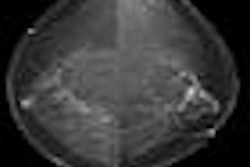Computer-aided detection (CAD) technology may yield breast cancer detection improvements in an independent double-reading mammography screening practice, according to a research team led by Dr. Per Skaane, Ph.D., of Ullevål University Hospital in Oslo, Norway.
"CAD offered a potential benefit of a 25% increase in cancer detection rate," Skaane said. He presented the research during a scientific session at the 2008 RSNA meeting in Chicago.
To determine the potential contribution of CAD to the cancer detection rate in an independent double-reading screening program, the researchers sought to compare the results of prospective double reading of film-screen mammography (FSM) and full-field digital mammography (FFDM) performed in the large-scale Oslo II breast cancer study with retrospective CAD usage on baseline mammograms with missed cancers.
The Oslo II study included a study population of 23,929 women, with an age range of 45 to 69, tested through the Norwegian Breast Cancer Screening Program (NBCSP). Of these patients, 16,985 (70%) received FSM and 6,944 (30%) received FFDM. The program utilized independent double reading, with a consensus meeting for positive exams (Radiology, September 2007, Vol. 244:3, pp. 708-717).
In this new study, missed cancers were defined as misses by one of two readers on baseline screening. Subsequent cancers (interval cancers or cancers discovered on the next screening round) that were missed by one or both readers on the baseline mammogram were also evaluated to see if a true-positive CAD mark was shown on the baseline mammogram.
In the Oslo II FSM group, the initial screening round found 64 cancers for a detection rate of 0.38%. Interval cancers contributed another 40 cases, while 42 more were found in a subsequent screening round. Version 8.0 of R2 Technology CAD software (Hologic, Bedford, MA) was then applied retrospectively to the FSM exams, and version 8.3 was utilized retrospectively for the FFDM studies.
Of the 64 cancers, there was concordant interpretation in 48 cases. CAD had a positive result in 46 (96%) of these studies. In the 16 cases with discordant interpretation, CAD had a positive result in 15 (94%) studies.
The Oslo II FFDM group was found to have 41 cancers during the initial screening round for a detection rate of 0.59%. Interval cancers added 12 more cases, and 15 more were discovered in a subsequent screening round.
Of the cancers found during the initial screening round, there were 31 concordant interpretations and eight discordant interpretations. CAD was positive in 28 (90%) of the concordant interpretations and in eight (100%) of the discordant interpretations, Skaane said.
Of the 104 subsequent cancers (interval cancers and those diagnosed on the next screening round), 20 were retrospectively classified from the baseline screening exams as "minimal sign, significant." Another nine were judged to be overlooked cancer.
If these were correctly marked by CAD, it would have the potential to increase the cancer detection rate, according to Skaane.
On the 80 subsequent cancers found on FSM, 17 were considered to be minimal sign actionable and seven were judged to be overlooked cancers, Skaane said. CAD was positive in 15 of the 17 minimal sign cases and in all seven of the missed cancers.
On the 24 subsequent cancers discovered in the FFDM group, three were considered to be minimal sign actionable and two were overlooked. CAD was positive in all five of these cases, Skaane said.
Including both FSM and FFDM cases, CAD was positive in 18 of 20 (90%) of the "minimal sign, significant" group and in all nine of the overlooked cancer group.
In conclusion, one of two readers missed 23% (24/103) of cancers that were detected by the other reader in the Oslo II study. Of these discordant cancer diagnoses, CAD correctly marked 96% (23/24), according to Skaane.
Also, one or both readers in the study missed 29 visible and actionable cancers that were subsequently diagnosed as interval or next-round cancers; CAD identified 26 of these, he said. If these marks were correctly acted upon, the breast cancer detection rate would have climbed 0.38% to 0.50% for FSM and from 0.56% to 0.63% for FFDM, an increase of 32% and 13%, respectively. The overall detection rate would have increased 25% (from 0.43% to 0.54%), according to Skaane.
The potential increase in recall rate due to false CAD marks was not evaluated in this study design.
By Erik L. Ridley
AuntMinnie.com staff writer
January 22, 2009
Related Reading
Interactive use of mammo CAD may improve mass detection, December 22, 2008
New mammo CAD approach lowers false positives, December 2, 2008
Norwegian mammo study claims to find cancer 'spontaneous regression,' November 24, 2008
NEJM study finds single reading with mammo CAD matches double reading, October 2, 2008
Study finds that CAD improves mammography's sensitivity, February 13, 2008
Copyright © 2009 AuntMinnie.com


















